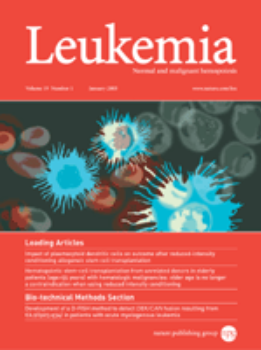Divergent molecular pathways drive monomorphic epitheliotropic and enteropathy-associated intestinal T-cell lymphoma.
IF 13.4
1区 医学
Q1 HEMATOLOGY
引用次数: 0
Abstract
Enteropathy-associated intestinal T-cell lymphoma (EATL) and monomorphic epitheliotropic intestinal T-cell lymphoma (MEITL) have distinctive clinical context, morphology, and immunophenotype. To characterize their genetic and molecular specificities, we compared 30 EATLs and 52 MEITLs by whole-exome, RNA and miRNA sequencing and DNA methylation profiling. Highly recurrent SETD2 loss-of-function alterations and frequent mutations of H3-3A/B consistently altering H3R2, implying deregulation of histone marks, were selectively found in MEITL. EATL instead harbored frequent mutations in TET2, ARID1A, and KMT2D. Highly prevalent JAK-STAT pathway mutations preferentially affected JAK3 and STAT5B in MEITL, and JAK1 and STAT3 in EATL. Half of EATLs contained disruptive mutations in HLA class I genes, impacting class I molecule expression. EATL containing more abundant macrophages was enriched in inflammatory response signatures, with upregulation of CD274, CXCL13, and IDO1 transcripts, suggesting an immunosuppressive tumor microenvironment. CpGs hypomethylated in MEITL compared to EATL were enriched in promoter regions. Unsupervised analyses of mutations, transcription, and methylation profiles concordantly segregated EATLs from MEITLs. In summary, the distinctive genetic, epigenetic, and expression footprints of EATL and MEITL established by this study expand disease-defining features, have diagnostic implications, and provide a rationale for targeted therapies.不同的分子通路驱动单纯性上皮性和肠病相关的肠t细胞淋巴瘤。
肠病相关肠t细胞淋巴瘤(EATL)和单形上皮性肠t细胞淋巴瘤(MEITL)具有不同的临床背景、形态和免疫表型。为了表征它们的遗传和分子特异性,我们通过全外显子组、RNA和miRNA测序以及DNA甲基化分析比较了30个eatl和52个MEITLs。高度复发的SETD2功能丧失改变和H3-3A/B频繁突变持续改变H3R2,这意味着组蛋白标记的放松,在MEITL中被选择性地发现。相反,EATL在TET2、ARID1A和KMT2D中经常发生突变。高度流行的JAK-STAT通路突变优先影响MEITL中的JAK3和STAT5B,以及EATL中的JAK1和STAT3。一半的eatl包含HLA I类基因的破坏性突变,影响I类分子的表达。含有更丰富巨噬细胞的EATL在炎症反应特征中富集,CD274、CXCL13和IDO1转录物上调,提示免疫抑制肿瘤微环境。与EATL相比,MEITL中低甲基化的CpGs在启动子区域富集。突变、转录和甲基化谱的无监督分析一致地从meitl中分离出eatl。总之,本研究建立的EATL和MEITL独特的遗传、表观遗传和表达足迹扩展了疾病定义特征,具有诊断意义,并为靶向治疗提供了依据。
本文章由计算机程序翻译,如有差异,请以英文原文为准。
求助全文
约1分钟内获得全文
求助全文
来源期刊

Leukemia
医学-血液学
CiteScore
18.10
自引率
3.50%
发文量
270
审稿时长
3-6 weeks
期刊介绍:
Title: Leukemia
Journal Overview:
Publishes high-quality, peer-reviewed research
Covers all aspects of research and treatment of leukemia and allied diseases
Includes studies of normal hemopoiesis due to comparative relevance
Topics of Interest:
Oncogenes
Growth factors
Stem cells
Leukemia genomics
Cell cycle
Signal transduction
Molecular targets for therapy
And more
Content Types:
Original research articles
Reviews
Letters
Correspondence
Comments elaborating on significant advances and covering topical issues
 求助内容:
求助内容: 应助结果提醒方式:
应助结果提醒方式:


